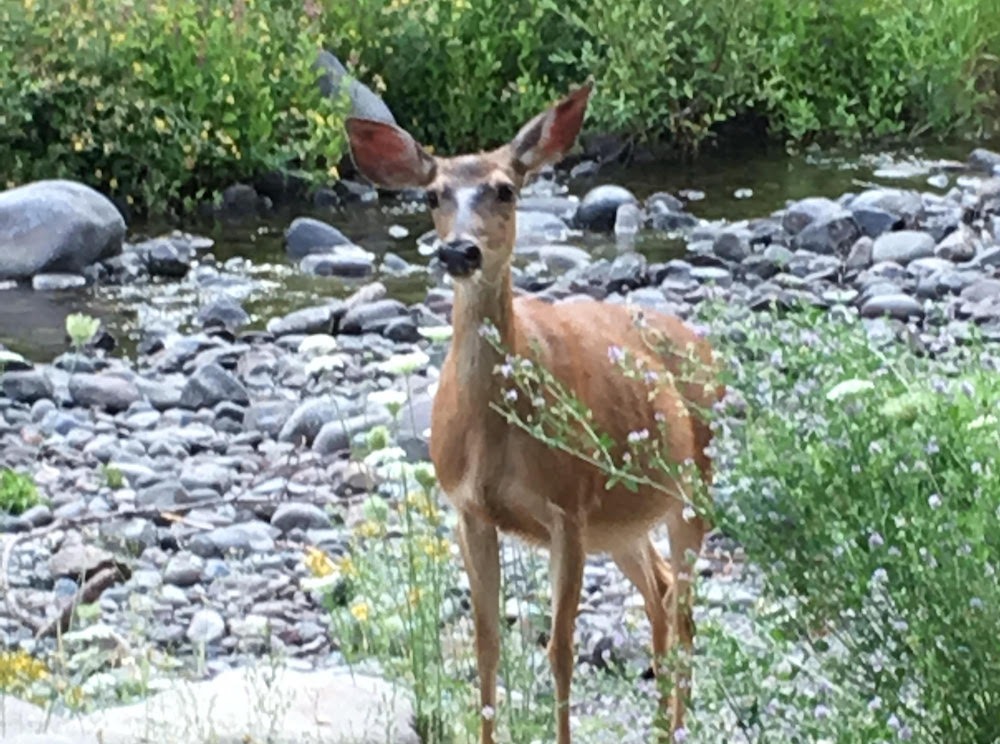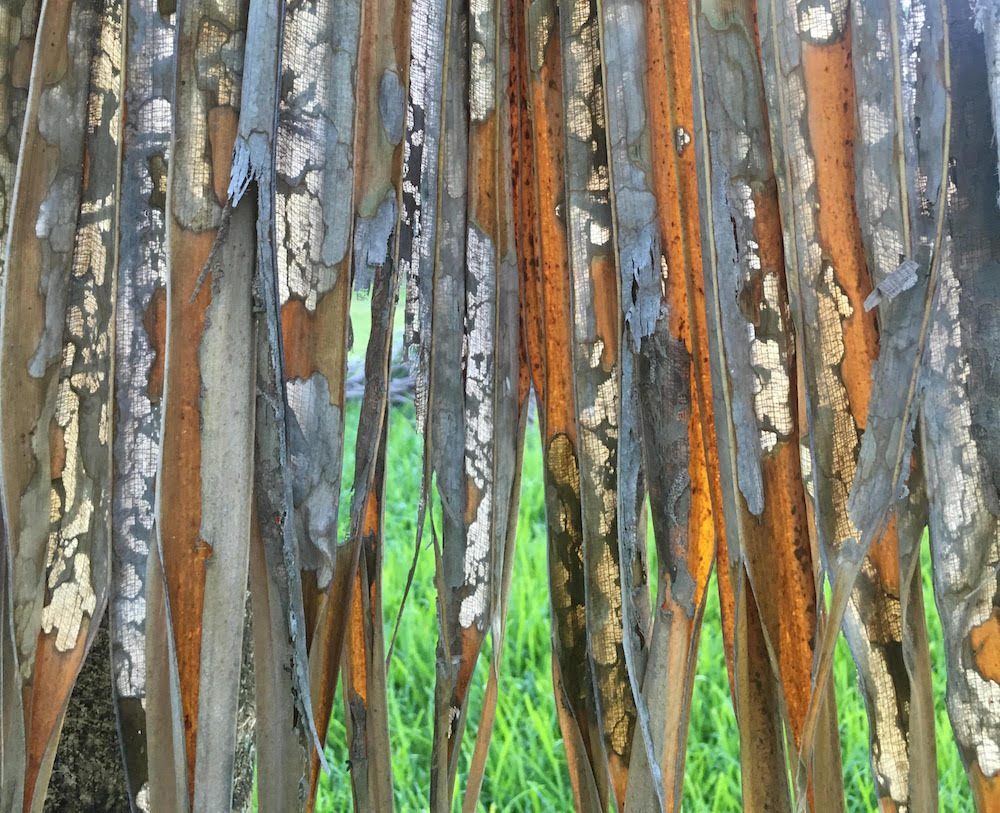Essay by Don Delo
Transcendentalism for Atheists

On an early, just-rising Sunday morning in the New Jersey woods, a deer just off the trail hides in plain sight by blending into her environment. I move, and she takes flight, disappearing into a thicket of mountain laurel. Ideas are like that.
“We don’t see with our eyes, we see with our brain,” I often said to my high school students, who were used to my “found it in the woods” declarations. I wanted them to understand that the eyes see more than the brain admits, that the brain decides which of the endless images to recognize, and that learning is often getting the brain to see something again for the first time. So, a deer-sighting becomes a metaphor, one I can use to get my students’ attention when they can’t see an idea hiding in their mental woods.
In his 1836 essay “Nature,” Ralph Waldo Emerson wrote, “In the woods we return to reason and faith.” During my godless, holy walks in the woods, reason and faith love to argue. Is reason an attempt to find an order that is there or to impose an order where there is none? Is faith a belief in an order beyond reason or a refusal to be reasonable? Are reason and faith contradictory or can they work together as Emerson suggests?
The questions—and my lack of answers—confuse me. Sometimes, when I look at the woods, at the leaves, trees, streams, rocks, and wildlife, I see a beautiful disorder, a perfectly imperfect mess of chaotic living and dying. But when I posed the question of order or chaos to Robert Richardson at a 1995 reading of his book Emerson: The Mind on Fire, he said, “Birth, life, death, decay. That’s order”—and another deer appeared.
• • •
“If I pick up this handful of forest floor, what do you see?” asked Jim decades ago. He was a naturalist with the New Jersey School of Conservation and cross-country skied up small mountains before breakfast “to get my blood going.” I was just out of college and new to woods-walking. We were hiking one of his “little known” trails. I looked into his hand, which was now full of twigs, rocks, dirt, and leaves.
“I see your future,” Jim said with a guru’s smile.
“Ouch,” I said.
It was a sobering handful of truth. Knowing I’m made of recycled matter that will forever be part of the birth-life-death-decay order, that my elements will mix with other elements and from that the future will grow, is supposed to ease my fear of death. But sometimes, my reason begs for the comforts of faith. I wish I could sing the sweet songs of afterlife.
• • •
In the sixties, a friend and I experimented with Wordsworth’s vision of stepping forth into the light of things and letting nature be our teacher. All institutionalized dogma was under attack, and the peace, love, and alternate mindset the woods offered seemed like the right path. Years later, when she was the director of the Meadowlands Environmental Center in Hackensack, New Jersey, she asked me to teach a deep-ecology-green-literature workshop to a summer seminar of high school science teachers. She thought the attempt to blend the empiricism of science and the romanticism of literature would be another way to take my confusion out for a walk.
A great way to learn anything is to teach it. Saying something you thought was clear only to be met by baffled student faces makes you dig deeper to find different, better words. It’s a magic trick. You say something one way, then you say it in other words, and with luck, clarity can be pulled from what seemed like an empty top hat. Everybody’s mind taps its toes to the same beat, and the room fills with an uncommon joy.
By the time I walked into that Meadowlands workshop in the early 1980s, I was ready. My course title was “Learning to Read Nature.” My thesis was that textbook ecology doesn’t speak to the soul, but if science teachers regularly added great writers to their lessons—the brilliant perceptions and images of essayists, novelists, and poets—students might go beyond aluminum-can recycling to embrace the life-death, night-day, water-cycle season-changing rhythms of the natural world.
I was dressed in muted earth tones, a living personification of the woods I was about to celebrate. I assured the group of sixteen science educators that I was one of them, that I too taught high school students, then started by reading the poem “When I Heard the Learn’d Astronomer” by Walt Whitman, which contrasts the astronomer’s “charts and graphs” with the poet’s “mystical moist night air.”
I followed Whitman with two killer quotes, bite-size delicacies meant to initiate sugar rushes of insight: “The lyric core of nature writing is the experienceable aspect of ecology” (John Muir) and “The environmental crisis…is a search for a return to a level of experience which is in tune with the poetry of humanity” (Peter Matthiessen).
It was a disaster. It was as though I were speaking Russian. The room was filled with the deafening silence that the writer Elizabeth Green has described as “the sound of no one thinking.” Lucretius, Steinbeck, Frost, Abbey, and Dillard hit the empirical minds of these science teachers like insects smashing into a windshield.
I felt like a fool. Their yawns made it clear they’d rather see nature through a microscope than through a poem and that these writers’ words, so essential to me they replaced religion as a way of organizing reality, were an invitation to nap.
• • •

My son has told me my house is “lousy with Buddhas.” I am not a Buddhist, but the icons of Buddhism (statues, singing bowls, om and yin-yang symbols) remind me of the power of being quietly alone in nature and listening to the stories it has to tell.
I recognize my confusion about reason and faith when I read Buddhist writing. It often begins with a disclaimer regarding the impossibility of articulating the realization Buddhists aspire to, followed by volumes that attempt to explain the unexplainable before ending with some version of the answer is there is no answer.
When I started reading Eastern philosophy, it was also reassuring to realize that Emerson and Thoreau were two of the first American scholars to read English translations of the Hindu bibles; what they were reading from India was what they were discovering in Massachusetts. This line of Emerson’s from “Nature”—“I become a transparent eyeball; I am nothing; I see all”—could be the definition of the Hindu concept of “at one.” Buddha felt it under a tree, Moses on a mountain, Jesus in a desert, and Muhammad in a cave. It can’t be a coincidence they were alone in nature when they made their discoveries.
• • •
I live in New Jersey near where the Shark River flows into a basin, through an inlet, and out into the Atlantic Ocean. Just before high tide, I like to paddle upriver into a small, narrowing tributary until my kayak can fit no farther, then wait for the tide to turn and drift slowly toward the sea.
Sitting on the water, floating silently into natural nooks, treats the eyes and mind to places invisible from land, and the experience is best when it coincides with sunrise. The sun lights the banks and creates mirror-clean reflections of land-in-water. I laugh when I stop thinking about where I am and simply am, until I snap back into self-awareness and feel lost. I laugh when a river otter pops its head above water, and we both jump. I laugh when I unintentionally disturb a blue heron’s patient fishing, and it takes flight with a squawk that sounds like a complaint.
But then I laugh because, as honest and real as the experience seems, when I return to the shore and the water continues out to sea, I know everything that happened was only what I imagined it to be. I think I get the joke. There is joy in the not-knowing, the frustration and exhilaration of exploring perceptions to create a personal mythology that makes you believe life means more than it probably does. And there is joy that transcends time and space, even if the biological bottom line is birth, life, death, decay.
Reason demands we create a semblance of order, an answer to why? The possibilities range from God to nothing, from divine design to chaos theory, from a lifelong test that determines your place in eternity to you-live-and-then-you-die. Is reason blind to possibilities beyond our capacity to perceive and articulate, or is faith just wishful thinking? I don’t know, and it’s likely I never will.
But I have reason to believe that moments of intense clarity have a rhythm that can be experienced in the here and now. I recognize a pulse that my body responds to without waiting for my mind’s permission. I sing words over and over until they become sounds that vibrate with where I am. I have felt the top of my head lift into the everything, read the words of others that describe the same feeling, enjoyed the power of paraphrasing the profound.
Underneath each moment, I’ve known there was a secular spirituality, a syncopation, a heartbeat drumming that made it feel like joy.
• • •
Last spring, I stood on a small rise in the middle of an open field, under a moody sky, surrounded by trees. I closed my eyes and imagined clouds collecting water from the ocean, dropping rain into mountain lakes that overflow into streams that fall over rocks until they join rivers that empty into oceans and repeat and repeat.
A breeze blew into, then through, my skin. It reminded me of dangling my bare feet in a cold stream, of standing beneath a waterfall, of lying on pine forest floors, watching a deer disappear into a thicket of mountain laurel.
Amen to Emerson’s “Experience,” in which he wrote that “to live the greatest number of good hours, is wisdom.” Reason is having faith that, the more often I feel this, the more joy I find in confusion.

Publishing Information
- Ralph Waldo Emerson: Selected Essays, Lectures, and Poems by Ralph Waldo Emerson, edited by Robert D. Richardson (Bantam Dell, 1990). The essays “Nature” and “Experience” were originally published in 1836 and 1844, respectively, by James Munroe and Company.
- Emerson: The Mind on Fire by Robert D. Richardson Jr. (University of California Press, 1995).
- “When I Heard the Learn’d Astronomer” by Walt Whitman from Walt Whitman: Selected Poems (Penguin, 1996); originally published in in 1865 by Peter Eckler.
- The Writings of John Muir, Manuscript Edition by John Muir (Houghton Mifflin, 1916).
- Wildlife in America by Peter Matthiessen (Viking, 1959).
- Building A Better Teacher by Elizabeth Green (Norton, 2014).
Art Information
- “Encounter,” “Om, Home Again” and “Looking Through the Veil” © Carol Jazzar; used by permission.
Don Delo is a city boy who somehow fell in love with Emerson, then the woods and the authors who wrote best about them. For 47 years, he tried to teach bright, urban, multicultural high school students how to see life through books and nature. Since retiring, he writes what he taught in order to see if he practiced what he preached.
